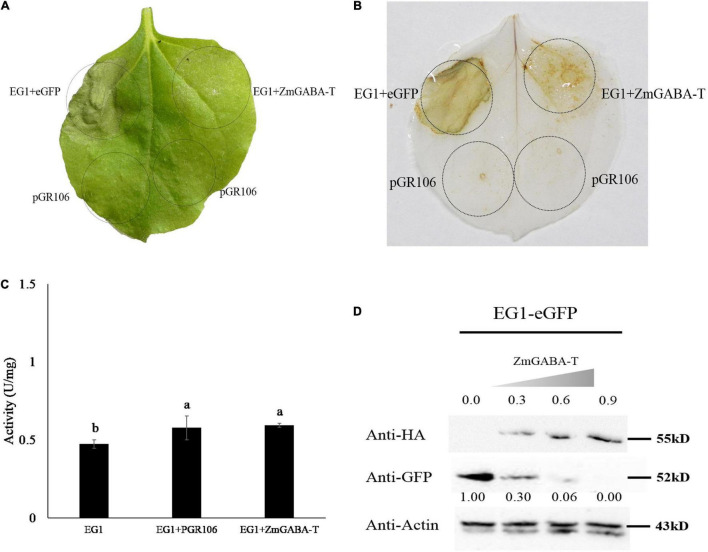FIGURE 3.
ZmGABA-T suppresses allergic necrosis induced by EG1 according to promoting the degradation of EG1, rather than inhibit the enzyme activity of EG1. (A) Transient expression of EG1 and ZmGABA-T in Nicotiana benthamiana. Transient expression was operated in Nicotiana benthamiana leaves injected with Agrobacterium carrying the indicated genes, pGR106, eGFP, EG1, and ZmGABA-T. eGFP and EG1 were coexpressed on the left of the leaf, and ZmGABA-T and EG1 were coexpressed on the right. Experiments were repeated three times at least with similar results. (B) ROS detection of EG1 and ZmGABA-T. The transient expression of Nicotiana benthamiana leaves inoculated with eGFP and EG1, ZmGABA-T and EG1 were dyed with 5 mg/mL DAB (3,3-diaminobenzidine). Transient expression was assessed in Nicotiana benthamiana leaves from 4-week-old plants 5 days after agroinfiltration, and pGR106 empty vector was used as a control. Experiments were repeated three times at least with similar results. (C) Enzyme activity determination of EG1 and ZmGABA-T. Co-incubation EG1 (1 μM) expressed by Pichia pastoris GS115 with pGR106 and ZmGABA-T expressed by Nicotiana benthamiana (2 mg/mL) separately at 50°C for 30 min, then dinitrosalicylic acid (DNS) was used to determine glucose content, and measured absorbance at OD540, thereby calculated enzyme activity of EG1. The results of the experiment were repeated three times at least. Lower-case letters indicate statistically significant differences (P < 0.05). (D) Co-expression of EG1-eGFP and ZmGABA-T-HA in Nicotiana benthamiana. The concentration of inoculation about ZmGABA-T was increased sequentially from OD600 = 0 to 0.9, while the concentration of EG1 was OD600 = 0.5. The numbers in the first row indicated the inoculation concentration of ZmGABA-T-HA. The numbers in the second row indicated the gray value of EG1. The results of the experiment were repeated three times at least.

